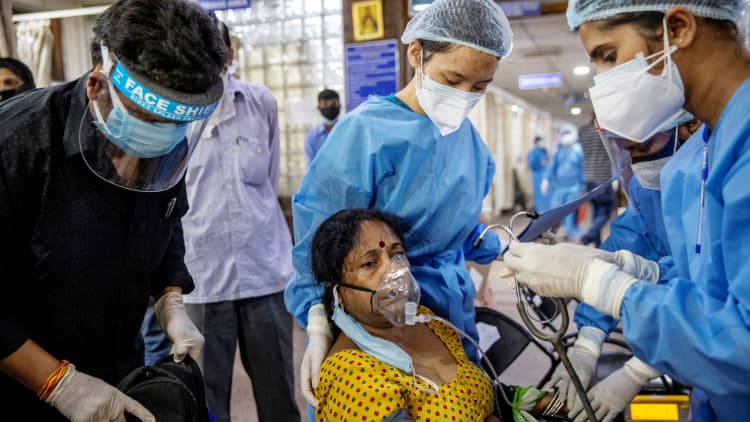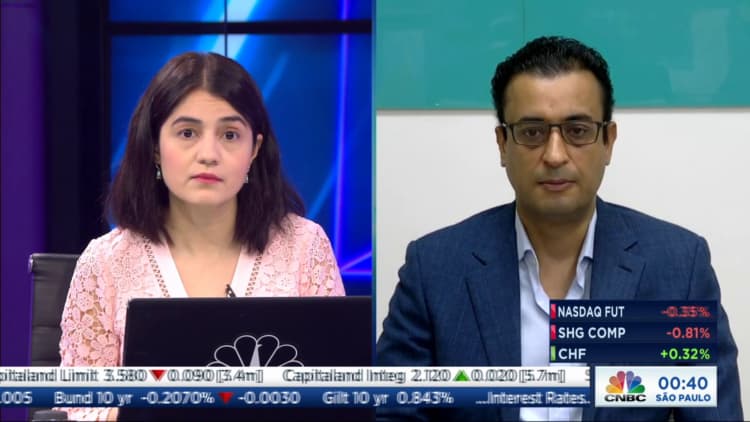India once again reported a record number of cases and fatalities on Thursday as it faces a devastating second wave of Covid-19 infections that has pushed its health-care system to the brink of collapse.
Health ministry data showed there were 412,262 new reported cases of infections over a 24-hour period, pushing the total tally to over 21 million — days after crossing the 20 million mark on Tuesday.
India also reported its highest daily death toll, with 3,980 fatalities. But media reports suggest that the death rate is being underreported.
Prime Minister Narendra Modi's government is facing criticism for allowing large crowds to gather for election rallies and religious festivals earlier this year as well as for failing to anticipate or prepare for a second wave.
India's oxygen crisis
Cases started rising in February but the second wave accelerated in April. The resurgence overwhelmed hospitals which are struggling with bed shortages as well as a limited supply of oxygen and medicines to treat patients. The international community has pledged to send medical aid in the form of oxygen cylinders, concentrators and other medical supplies. Some of those aid shipments have started arriving in India, according to reports.
The situation, however, has not eased because the number of cases is moving up as is the severity of those cases, according to Abhay Soi, chairman and managing director of Max Healthcare, which has hospitals in Delhi, Maharashtra, Punjab and Uttarakhand.

"That means essentially the requirement for oxygen (is) also moving up," he said Tuesday on CNBC's "Street Signs Asia."
"Typically an ICU requires two-and-a-half to three times the amount of oxygen a ward or a patient in a bed requires. So, as criticality moves up, as mortality moves up, you are going to see the requirement of oxygen also move up," he said.
Soi explained that Max Healthcare conducts about 4,000 RT-PCR tests in the Delhi area per day and about a week ago, those Covid-19 tests had a positivity rate of over 50%, which has since come down to about 31%.

"So what you are going to see right now is people who were infected about seven, eight days ago, coming into hospitals," he said, adding these patients need a host of medicines and support, including oxygen.
Courts step in
On Wednesday, India's Supreme Court ordered the central government to present a comprehensive plan by Thursday outlining steps it will take to meet medical oxygen requirements for hospitals in Delhi, including sources of supply and transport provisions. The country's top court also stayed a contempt notice issued by the High Court of Delhi on May 4 to the central government for not complying with its orders to supply sufficient oxygen to hospitals in Delhi.
Delhi high court justices Vipin Sanghi and Rekha Palli noted on Tuesday that hospitals and nursing homes have had to reduce the number of beds offered because they are unable to service their existing capacities due to a shortage of medical oxygen.
The National Capital Territory of Delhi, which includes India's capital New Delhi, is one of several areas that saw a rapid surge in cases, forcing the local government to step up restrictions to try and break the chain of transmission.
Logistics issue
India has sufficient oxygen available, but the main issue lies around logistics, according to Siddharth Jain, director of Inox Air Products, one of India's prominent industrial and medical gases manufacturers.
Jain told CNBC's "Street Signs Asia" on Wednesday that the country's oxygen manufacturers have stepped up production by more than 30% in recent weeks. He said over 9,000 tons of oxygen is available in India per day while consumption of medical oxygen is slightly higher than 7,500 tons.

"There certainly is plenty of oxygen available. It's just that we have to get the logistics right. It's available in parts of India, which are far away from the parts of consumption," Jain said. He explained that most of India's oxygen production happens in the Western and Eastern states, some of which are relatively less densely populated and therefore do not require as much oxygen.
"Delhi is certainly the capital of India, but the oxygen requirement is across the nation," he said, pointing out that there are challenges in moving oxygen from one part of India to another.
Max Healthcare's Soi, however, said that while logistics have improved, there are still some gaps that need to be filled.
For its part, the Indian government has stepped up efforts to streamline the supply of oxygen in the country. It set up two medical oxygen plants in New Delhi within a week and has allocated funds to install 500 such plants across India within the next three months.


